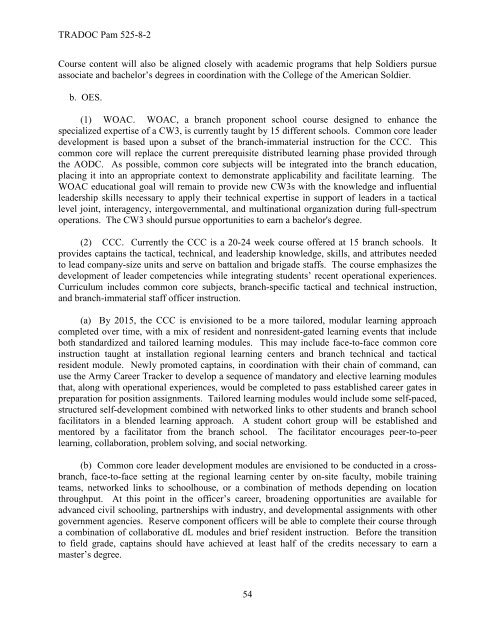K3zgZ
K3zgZ
K3zgZ
Create successful ePaper yourself
Turn your PDF publications into a flip-book with our unique Google optimized e-Paper software.
TRADOC Pam 525-8-2<br />
Course content will also be aligned closely with academic programs that help Soldiers pursue<br />
associate and bachelor’s degrees in coordination with the College of the American Soldier.<br />
b. OES.<br />
(1) WOAC. WOAC, a branch proponent school course designed to enhance the<br />
specialized expertise of a CW3, is currently taught by 15 different schools. Common core leader<br />
development is based upon a subset of the branch-immaterial instruction for the CCC. This<br />
common core will replace the current prerequisite distributed learning phase provided through<br />
the AODC. As possible, common core subjects will be integrated into the branch education,<br />
placing it into an appropriate context to demonstrate applicability and facilitate learning. The<br />
WOAC educational goal will remain to provide new CW3s with the knowledge and influential<br />
leadership skills necessary to apply their technical expertise in support of leaders in a tactical<br />
level joint, interagency, intergovernmental, and multinational organization during full-spectrum<br />
operations. The CW3 should pursue opportunities to earn a bachelor's degree.<br />
(2) CCC. Currently the CCC is a 20-24 week course offered at 15 branch schools. It<br />
provides captains the tactical, technical, and leadership knowledge, skills, and attributes needed<br />
to lead company-size units and serve on battalion and brigade staffs. The course emphasizes the<br />
development of leader competencies while integrating students’ recent operational experiences.<br />
Curriculum includes common core subjects, branch-specific tactical and technical instruction,<br />
and branch-immaterial staff officer instruction.<br />
(a) By 2015, the CCC is envisioned to be a more tailored, modular learning approach<br />
completed over time, with a mix of resident and nonresident-gated learning events that include<br />
both standardized and tailored learning modules. This may include face-to-face common core<br />
instruction taught at installation regional learning centers and branch technical and tactical<br />
resident module. Newly promoted captains, in coordination with their chain of command, can<br />
use the Army Career Tracker to develop a sequence of mandatory and elective learning modules<br />
that, along with operational experiences, would be completed to pass established career gates in<br />
preparation for position assignments. Tailored learning modules would include some self-paced,<br />
structured self-development combined with networked links to other students and branch school<br />
facilitators in a blended learning approach. A student cohort group will be established and<br />
mentored by a facilitator from the branch school. The facilitator encourages peer-to-peer<br />
learning, collaboration, problem solving, and social networking.<br />
(b) Common core leader development modules are envisioned to be conducted in a crossbranch,<br />
face-to-face setting at the regional learning center by on-site faculty, mobile training<br />
teams, networked links to schoolhouse, or a combination of methods depending on location<br />
throughput. At this point in the officer’s career, broadening opportunities are available for<br />
advanced civil schooling, partnerships with industry, and developmental assignments with other<br />
government agencies. Reserve component officers will be able to complete their course through<br />
a combination of collaborative dL modules and brief resident instruction. Before the transition<br />
to field grade, captains should have achieved at least half of the credits necessary to earn a<br />
master’s degree.<br />
54




